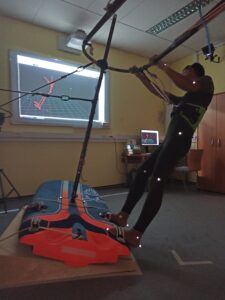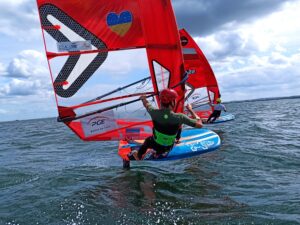Celem projektu było wskazanie pozycji ustawienia ciała (pozycji zawodniczej) w windsurfingu klasy iQFOiL, która w sposób najbardziej efektywny będzie przekładała się na maksymalizację prędkości poruszania się zawodnika na wodzie. Powstanie klasy iQFOi związane jest z wprowadzenia nowej technologii w windsurfingu – hydrofoili. Jest to powierzchnia nośna umieszczona na końcu statecznika deski zanurzonego w wodzie. Zastosowanie hydroskrzydła skutkuje uniesieniem deski ponad wodę, co zmniejsza stawiany przez nią opór i umożliwia płyniecie z większą prędkością. Obecnie aby uzyskać najlepsze efekty zawodnicy testują różne ustawienia (pozycje ciała) podczas pływania, kierując się intuicją i doświadczeniem. Optymalny model nie został jeszcze jednak wypracowany.
Projekt składał się z trzech etapów: opracowania metody szacowania położenia środka ciężkości (OSC) zawodnika na podstawie zdjęć 2D, wskazania predyspozycji do uprawiania windsurfingu w klasie iQFOiL na podstawie oceny cech antropometrycznych i wzorców ruchowych, badania wpływu pozycji ciała zawodnika na prędkość płynięcia.
W pierwszym etapie projektu wykorzystano możliwości Laboratorium Biomechaniki na Politechnice Poznańskiej. Przy pomocy systemu motion capture rejestrowano pozycję zawodnika na desce. Pozyskane w ten sposób dane pozwoliły na dokładne określenie położenia środka ciężkości ciała, co później zostało wykorzystane do opracowania metody szacowania położenia środka ciężkości, na podstawie zdjęć 2D w warunkach regatowych. Pozycje zawodników porównano z ich prędkościami płynięcia po Zatoce Gdańskiej.
Projekt był współrealizowany przez Polski Związek Żeglarski, Rehasport Clinic sp. z o.o., Uniwersytet Medyczny w Poznaniu oraz Politechnikę Poznańską, a także finansowany ze środków Ministerstwa Sportu i Turystyki w ramach wspierania projektów naukowych w zakresie sportu wyczynowego w 2022 roku.


